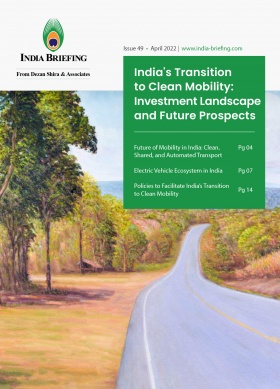Investment Opportunities in India’s Transition to a Low-Carbon Economy
India’s transition to a low-carbon economy will demand a vast amount of funding over the next five decades. The soon-to-be world’s most populous nation aims to reach net-zero by 2070, making it the last of the world’s largest emitters to do so. However, this enormous transition creates a wealth of opportunity for green investment in the energy sector, the carbon capture sector, and in electric vehicles, among others.
Climate change is rightly at the forefront of global cooperation. While climate fluctuations are a natural phenomenon, which have had profound economic and social impacts throughout history, human activities have been the main driver of climate change in the last two centuries. Experts have warned that climate change may be irreversible if the current trajectory is sustained.
In this article, we discuss the approach to climate action in India and emerging investment opportunities, whose scale and scope will be influenced by the country’s need to manage demographic factors, achieve economic growth, maintain energy security, and reduce net-carbon emissions.
Population growth and India’s emissions record
India is central to global efforts to reduce emissions. The country’s population is surging in parallel with its economy. In 2023, India is set to become the world’s most populous nation – overtaking China. The average age in India is nearly a decade younger than that in China, at 28.43 years old. One in every five Gen Zers in the world lives in India.
While India’s per capita emissions rate is low in relative terms (1.8 tons CO2), the country is the world’s third largest emitter – emitting a net 2.9 gigatons of carbon-dioxide equivalent (GtCO2e) per year – by virtue of its size, population, and reliance on carbon-intensive energies and industry. Around 70 percent of emissions are traced to six sectors: power, steel, automotive, aviation, cement, and agriculture.
India’s youth concerns over sustainability
India’s young population will likely play an important role in defining their country’s response to climate change. According to analysts at the consultancy firm McKinsey, 68 percent of Gen Zers in India reported feeling anxiety about climate change. The firm highlights that young people appear to be greatly concerned about the impact of climate change on work and living conditions. Of those surveyed by McKinsey, 30 percent have cited sustainability as a key concern when considering an employer.
India’s decarbonization potential
In 2021, India announced its ambition to become a net-zero emitter by 2070. The target marks an important milestone in the fight against climate change, but sees the nation lag China – which aims to reach net-zero by 2060 – and developed nations like the UK, which aims to reach it at 2050.
India has the potential to create 287 gigatons of carbon space for the world. This figure is substantial and amounts to half of the global carbon budget required to limiting warming to 1.5°C. However, as McKinsey notes in its report ‘Decarbonising India: Charting a Pathway for Sustainable Growth’, the current pace of emissions intensity reduction is insufficient. Taking the historical trajectory, India’s annual emissions could rise to 11.8 GtCO2e by 2070. Under the current Line of Sight scenario, emissions would be reduced to 1.9 GtCO2e by 2070, a 90 percent reduction in economic emissions intensity compared with 2019. Under an accelerated scenario, the emissions could fall to 0.4 GtCO2e by 2050 – partially dependent on new technology developments (such as direct air capture) – allowing net-zero by 2070.
Investment opportunities in India
In order to meet its carbon emissions promises, India requires funding and investment, much of it front loaded. The McKinsey report suggests that as much as 3.5–six percent of GDP will be needed. This anticipates US$7.2 trillion of green investments required under the current Line of Sight scenario in the years to 2050. A further US$4.9 trillion would be needed under an accelerated scenario.
While funding is one aspect, policy development is another. India’s government will need to make continuous improvements to the frameworks surrounding green energy, electric vehicle adoption, and new technologies. India currently lacks sector-specific targets in several areas and these will be needed to gauge progress and develop policies that can enhance investment and carbon emission reductions.
Despite this, it is worth noting that India’s decarbonization efforts are well and truly underway. The sector attracts plenty of investment, including US$2 billion in private capital that went into Indian climate change-related technology in the first half of 2022. According to the Washington Post, some of India’s biggest companies are looking to lead on indigenous sustainability efforts. The likes of Wipro Ltd., UltraTech Cement Ltd. and Reliance Industries are increasingly talking to their shareholders about sustainability, the paper highlighted.
However, it is clear that much greater levels of investment are required if India is to reach its climate change targets. Investment opportunities can be split by sector:
|
Sector |
Details |
|
Renewable energy |
|
|
EV Adoption |
|
|
Green hydrogen production |
|
|
Decarbonization of agriculture |
|
|
Natural climate solutions |
|
|
Carbon capture, utilization and storage |
|
Transition headwinds
India’s 2070 net-zero target leaves it dead last among the world’s largest emitters. However, as the least developed of the largest emitters, experts insist this is the way it should be. If managed poorly, decarbonization could leave millions of Indians struggling for access to basic staples as dirty, yet cheap, fuels are removed from the market.
The fragile nature of this transition is currently being highlighted in Europe as energy security has been compromised by Russia’s war in Ukraine. If renewables are unable to fill the void left by hydrocarbons, energy prices could skyrocket, leading to inflationary pressure across the economy. Policy enactments will need to ensure that India’s poorest are protected from inflationary pressure that the transition may cause.
The need to make provisions for India’s poor during the transition is accentuated by climate change, which has increased the frequency of extreme heat waves, droughts, and rains. In turn, this puts greater pressure on poorer farming communities, among others, as well as increasing the need for energy-intensive air conditioning and heating during weather extremes.
About Us
India Briefing is produced by Dezan Shira & Associates. The firm assists foreign investors throughout Asia from offices across the world, including in Delhi and Mumbai. Readers may write to india@dezshira.com for more support on doing business in in India.
We also maintain offices or have alliance partners assisting foreign investors in Indonesia, Singapore, Vietnam, Philippines, Malaysia, Thailand, Italy, Germany, and the United States, in addition to practices in Bangladesh and Russia.
- Previous Article Australia Ratifies Landmark Free Trade Agreement with India
- Next Article Profiling Major Segments in India’s Education Industry









